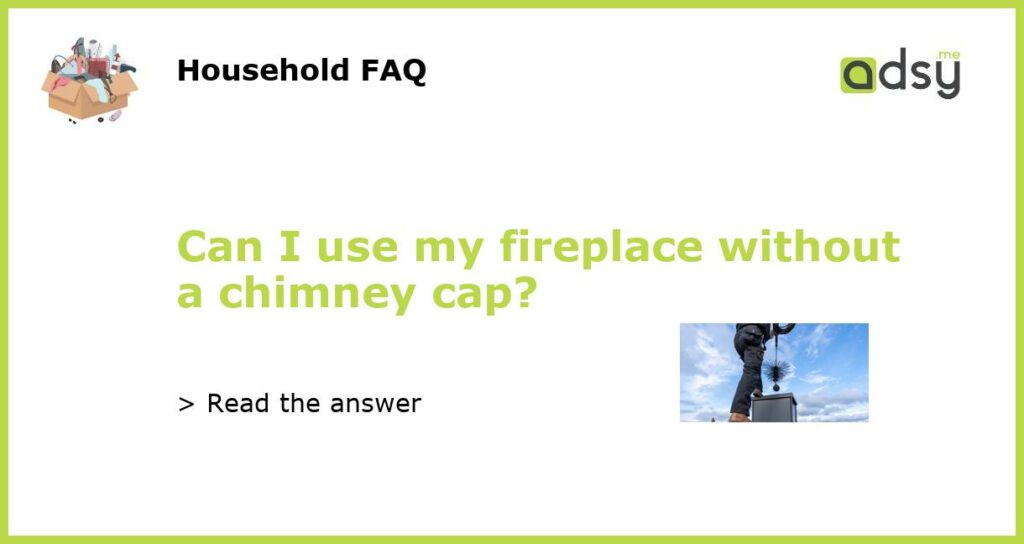Can You Use Your Fireplace Without a Chimney Cap?
It’s a cold winter evening, and you want to cozy up in front of the fireplace. But wait, do you have a chimney cap? Many homeowners wonder if it’s safe to use their fireplace without one. In this article, we’ll explore the purpose of a chimney cap, the potential risks of not having one, and whether it’s advisable to use your fireplace without a chimney cap.
1. The Purpose of a Chimney Cap
A chimney cap is a metal barrier that covers the top of your chimney. Its primary function is to keep debris, animals, and rainwater from entering your chimney and home. Without a chimney cap, leaves, twigs, and other debris can accumulate in your chimney, obstructing the airflow and potentially causing a dangerous buildup of flammable materials. A chimney cap also prevents animals like birds, squirrels, or raccoons from nesting in your chimney, which can lead to blockages and other hazards.
The Risks of Not Having a Chimney Cap
Using your fireplace without a chimney cap can pose several risks. Firstly, as mentioned earlier, debris can accumulate and block the airflow in your chimney. This can lead to incomplete combustion, causing smoke and harmful gases, such as carbon monoxide, to enter your home. Carbon monoxide is odorless, colorless, and highly toxic, making it a significant health hazard.
Secondly, without a chimney cap, animals can easily make their way into your chimney. They may build nests, leave droppings, or even get stuck, which can further obstruct the airflow and create a fire hazard. In some cases, animals can also cause damage to your chimney liner or other chimney components, leading to costly repairs.
Lastly, a chimney cap helps prevent rainwater from entering your chimney. When rainwater enters your chimney, it can mix with soot or creosote deposits and create a corrosive mixture. Over time, this can damage the interior walls of your chimney, leading to structural issues and water leaks.
Alternative Measures
If you don’t have a chimney cap or it gets damaged and needs replacement, you might wonder if there are alternative measures you can take. While it’s always recommended to have a chimney cap professionally installed, there are temporary solutions that can help mitigate some risks.
One possible solution is using a chimney balloon. A chimney balloon is a temporary inflatable barrier that you can insert into your chimney flue. It helps prevent downdrafts, rainwater, and animals from entering your chimney. However, it’s essential to note that a chimney balloon is not a permanent solution and should not be used while operating a fireplace.
Another option is to cover your chimney temporarily with a tarp or other waterproof material. This can provide some protection against rainwater while you wait for a chimney cap replacement. However, keep in mind that this is not a long-term solution, and you should consult a professional chimney sweep for proper advice and installation.
The Importance of Professional Installation
Installing a chimney cap is not a DIY task. It’s essential to hire a professional chimney sweep who can assess your chimney and recommend the appropriate cap for your specific needs. A professional can ensure that the cap is securely installed, properly sized, and resistant to birds or other animals attempting to remove it.
Professional installation also includes a thorough chimney inspection, which can identify any existing issues or potential hazards. A chimney sweep will clean your chimney, remove any blockages, and make sure that your fireplace and chimney are safe to use. Regular chimney maintenance, including the installation of a chimney cap, is crucial to preventing chimney fires and maintaining the longevity of your chimney system.
Conclusion
In conclusion, it is not advisable to use your fireplace without a chimney cap. A chimney cap plays a crucial role in protecting your chimney and home from debris, animals, and rainwater. Using your fireplace without a chimney cap can lead to blockages, poor airflow, and potential health and safety hazards. If you do not have a chimney cap or need a replacement, consult a professional chimney sweep for proper installation and maintenance. Your safety and the functionality of your chimney system should always be a priority.

